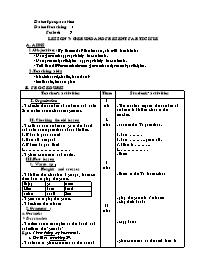Bài soạn môn học Tiếng Anh lớp 11 - Period: 7 - Lesson 7: Gerund and present participle

A. AIMS
1. Objectives : By the end of the lesson, sts will be able to:
- Use gerunds appropriately in contexts.
- Use present participles appropriately in contexts.
- Tell the difference between gerunds and present participles.
2. Teaching aids:
- blackboard, chalk, handouts
- textbook, lesson plan
B. PROCEDURES
Bạn đang xem tài liệu "Bài soạn môn học Tiếng Anh lớp 11 - Period: 7 - Lesson 7: Gerund and present participle", để tải tài liệu gốc về máy bạn click vào nút DOWNLOAD ở trên
Date of preparation: Date of teaching : Period: 7 Lesson 7: gerund and present participle A. Aims 1. Objectives : By the end of the lesson, sts will be able to: - Use gerunds appropriately in contexts. - Use present participles appropriately in contexts. - Tell the difference between gerunds and present participles. 2. Teaching aids: - blackboard, chalk, handouts - textbook, lesson plan B. Procedures Teacher’s activities Time Students’ activities I. Organization - T checks the number of students and asks Ss to make some class arrangement. II. Checking the old lesson - T calls on one student to go to the board and asks some questions about him/her. 1. What is your name? 2. How old are you? 3. Where do you live? 4. - T gives comments and marks. III. New lesson 1. Warm- up : Noughts and crosses - T divides the class into 2 groups, instructs them how to play the game. Enjoy go meet Like does heard arrive avoid See - T gets sts to play the game. - T declares the winner 2. Grammar : a. Gerunds: * Presentation - T writes some examples on the board and underlines the “gerunds” Eg: + I hate doing my homework. + She likes watching TV. - T asks sts to give comment on the use of “gerund” in these examples. - T reviews the verbs followed by “gerund” in the examples quickly. Form: Ving Use: Gerund is used in these cases: + As subject of the sentence. Eg: Swimming is a good exercise. + As object of the verb. Eg: I like watching TV. + As complement of “be” Eg: My passion is studying. + After preposition Eg:She is interested in learning English b. Present participle: * Presentation - T writes some examples on the board and underlines the “V-ing” Eg: + Seeing him, I stopped to greet him + I heard someone falling outsides. - T asks sts to give comment on the use of “gerund” in these examples. - T introduces the use of present participle. Form: V-ing Use: used as a non-finite clause (ing clause) c. Difference: - T gets sts to tell the difference between the gerund and present participle. Gerunds are used as a noun and present participles are used as a non-finte clause. - T repeats the difference * Practice (handouts) IV. Consolidation - T summarises the main points of the lesson. V. Homework - T asks sts to do the extra exercises in the workbook. VI. Feedback 1. Good points 2. Weak points 1 min 4 mins 5 mins 15 mins 17 mins 2 mins 1 min - The monitor reports the number of students in his/her class to the teacher. - answer the T’s questions. 1. I am 2. I am .. years old. 3. I live in .. 4. . - listen - listen to the T’s instructions - play the game in 3 minutes - clap their hands - copy down - give comment on the verb form in these examples. - listen to T and copy down - copy down - give comment on the verb form in these examples. - listen to T and copy down - tell the difference between the gerund and present participle. - listen and copy down. - take note - take note
Tài liệu đính kèm:
 Option 7 for 7th week.doc
Option 7 for 7th week.doc





